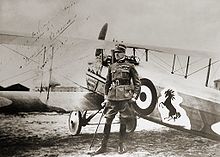Francesco Baracca
| Francesco Baracca | |
|---|---|

|
|
| Born |
9 May 1888 Lugo di Romagna, Italy |
| Died | 19 June 1918 (aged 30) Vicinity of Mount Montello, Italy |
| Allegiance | Italy |
| Service/branch | Cavalry; aviation |
| Years of service | 1907 – 1918 |
| Rank | Major |
| Unit | 1a Squadriglia, 70a Squadriglia, 91a Squadriglia |
| Awards | Gold Medal of Military Valor, three Silver Medal of Military Valor, British Military Cross, French Croix de Guerre, Belgian Order of the Crown |
Count Francesco Baracca (9 May 1888 – 19 June 1918) was Italy's top fighter ace of World War I. He was credited with 34 aerial victories. The emblem he wore side by side on his plane of a black horse prancing on its two rear feet inspired that of Ferrari.
Baracca was born in Lugo di Romagna. He was the son of a wealthy landowner. The younger Baracca initially studied at a private school in Florence before entering the Military Academy of Modena in October 1907. As he had become a passionate equestrian as an antidote to classroom boredom, he became a cavalryman with the prestigious Piemonte Reale Cavalleria Regiment upon his commissioning in 1910. His first duty station allowed him to attend concerts and opera in Rome, as well as pursuing hunting and equestrian competitions; he gained some fame in the latter. This little idyll was spoiled by orders to a small town in central Italy. Baracca then became interested in aviation and learned to fly at Reims, France, receiving his pilot's license on 9 July 1912. He then served with the Battaglione Aviatori and in 1914 with the 5th and 6th Squadriglie.
During the months between the outbreak of World War I and Italy's entry into the war, there was intense political controversy in Italy between pro-war and pro-peace factions. Baracca remained aloofly neutral, but ready to serve his nation. After Italy's entry into the war on the Entente side in May 1915, he was sent to Paris to convert to Nieuport two-seaters. Upon his return in July, he was assigned to the 8a Squadriglia Nieuport. The Nieuport 10s that equipped this squadron were almost useless against Austro-Hungarian raids; they were too slow, with too slow a rate of climb, to bring the intruders to battle with any regularity. The frustrated Italian pilots even resorted to leaving their observers ground-bound in attempts to improve performance, to little avail. On those rare occasions when battle was joined, the Nieuports' guns usually jammed. Renaming the unit to 1a Squadriglia Caccia on 1 December 1915 did nothing to solve the problems.
The Nieuport 11 single-seat fighter with Lewis guns entered service in April 1916, and on 7 April, flying this new fighter, Baracca scored his first victory, holing the fuel tank of an Austrian Hansa-Brandenburg C.I and wounding its two-man crew. This was also Italy's first aerial victory in the war. This first victory featured his favorite manoeuvre, which was to zoom in unseen behind and below an enemy and fire his machine gun from pistol range.
...
Wikipedia
